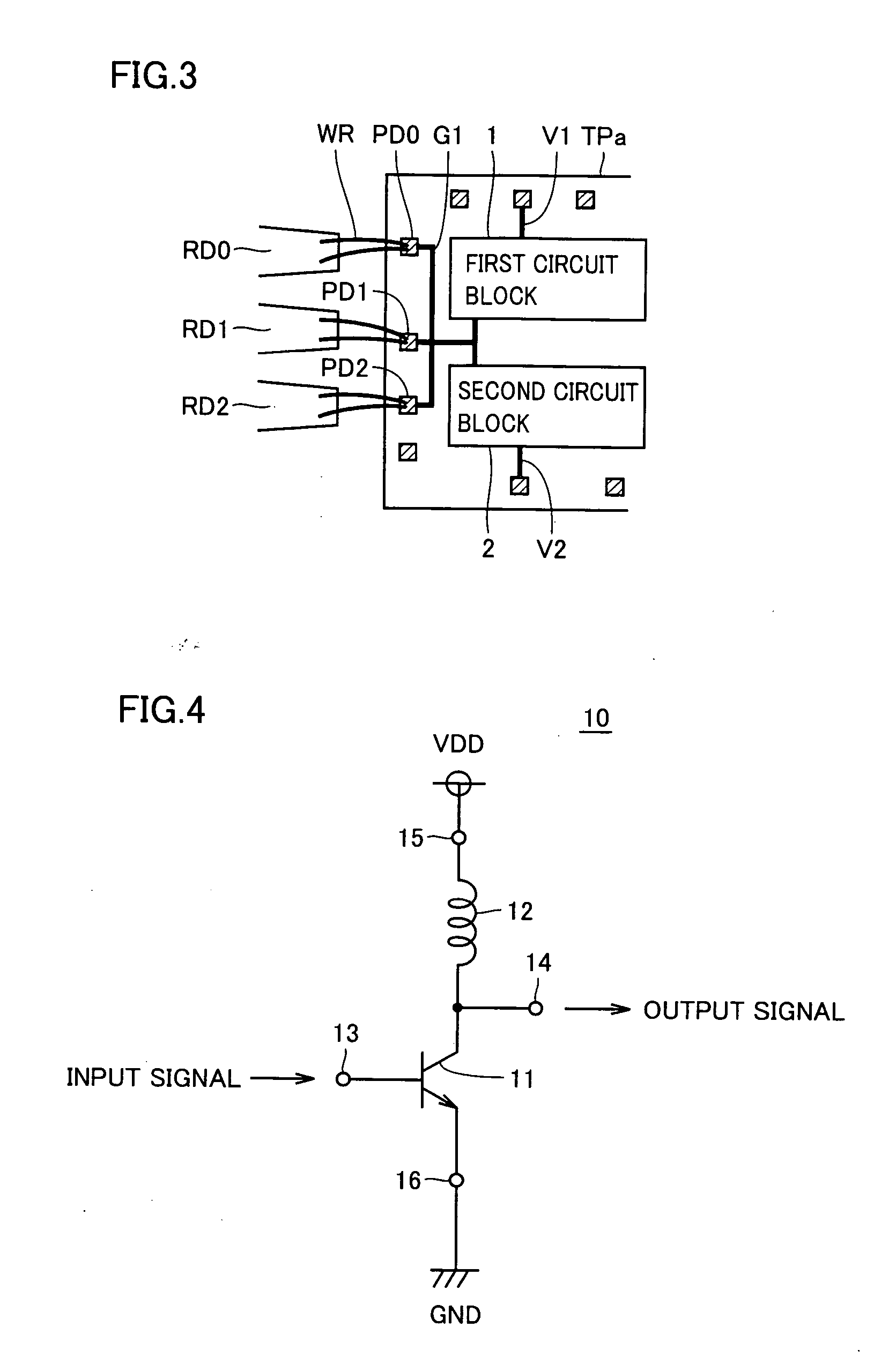Semiconductor integrated circuit device which restricts an increase in the area of a chip, an increase in the number of lead terminals of a package, and can reduce parasitic inductance
a technology of integrated circuits and semiconductors, applied in semiconductor devices, semiconductor/solid-state device details, electrical devices, etc., can solve the problems of affecting the circuit properties of integrated circuit chips, becoming critical problems, and significantly deteriorating circuit properties, so as to reduce parasitic inductance, increase the chip area, and increase the number of lead terminals
- Summary
- Abstract
- Description
- Claims
- Application Information
AI Technical Summary
Benefits of technology
Problems solved by technology
Method used
Image
Examples
first embodiment
[0031] In reference to FIG. 1, an integrated circuit chip TP according to a first embodiment of the present invention includes first to fourth circuit blocks 1 to 4, a number of bonding pads PD which are placed in the peripheral region of the circuit blocks, VDD lines V1 to V4, and GND lines G1, G3 and G4. First to fourth circuit blocks 1 to 4 are connected to respective corresponding VDD lines V1 to V4, so as to receive a supply of a power supply voltage VDD. In addition, first and second circuit blocks 1 and 2 are commonly connected to GND line G1, so as to receive a supply of a ground voltage GND from GND line G1. In addition, third and fourth circuit blocks 3 and 4 receive a supply of ground voltage GND from GND lines G3 and G4, respectively. In the present embodiment, the input / output lines to / from respective circuit blocks 1 to 4 are omitted. Here, the VDD lines and the GND lines are power supply lines for supplying power supply voltage VDD and ground voltage GND, respectively...
second embodiment
[0038] In reference to FIG. 2, an integrated circuit chip TPa according to a second embodiment of the present invention is different from integrated circuit chip TP according to the first embodiment of the present invention, in that GND line G1 is connected to three bonding pads PD0 to PD2. Other portions are the same as in integrated circuit chip TP of FIG. 1, and therefore, the detailed descriptions thereof are not repeated. Here, parts that are the same in the respective drawings are denoted by the same symbols.
[0039] In the chip configuration according to the second embodiment of the present invention, the above described GND line GI is shared by a number of circuit blocks, providing a state of connection to a number of bonding pads PD that are not being utilized, and therefore, it becomes possible to reduce the parasitic inductance, due to the connection of a plurality of bonding wires, while restricting an increase in the number of GND terminals as a whole.
[0040] Here, thoug...
fourth embodiment
[0045] In reference to FIG. 4, a grounded emitter amplifier circuit 10 according to a fourth embodiment of the present invention includes a bipolar transistor 11, a load inductor 12, an input terminal 13 for grounded emitter amplifier circuit 10, an output terminal 14 for grounded emitter amplifier circuit 10, a power supply terminal 15 that is connected to a VDD line, and a GND terminal 16 that is connected to a GND line.
[0046] Grounded emitter amplifier circuit 10 amplifies an input signal from input terminal 13 by a predetermined amplification ratio on the basis of load inductor 12 and bipolar transistor 11, and outputs the resulting signal to output terminal 14.
[0047] In the case where such a grounded emitter amplifier circuit 10 is provided as a first circuit block in FIGS. 1 to 3, for example, the impedance between the emitter and the ground of the grounded emitter amplifier circuit is reduced when GND terminal 16 is connected to the GND line, as in FIGS. 1 to 3. Accordingly...
PUM
 Login to View More
Login to View More Abstract
Description
Claims
Application Information
 Login to View More
Login to View More - R&D
- Intellectual Property
- Life Sciences
- Materials
- Tech Scout
- Unparalleled Data Quality
- Higher Quality Content
- 60% Fewer Hallucinations
Browse by: Latest US Patents, China's latest patents, Technical Efficacy Thesaurus, Application Domain, Technology Topic, Popular Technical Reports.
© 2025 PatSnap. All rights reserved.Legal|Privacy policy|Modern Slavery Act Transparency Statement|Sitemap|About US| Contact US: help@patsnap.com



